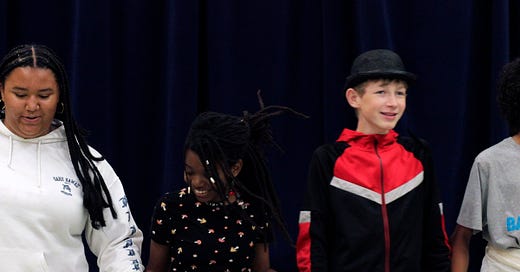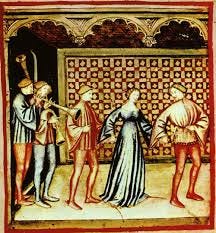Bransles - Playful Medieval Dances Make History Come Alive in the Classroom
In June, 2025, Dancing Through the Ages course from Spacial Dynamics Institute featured these dances among others. We share some program resources here with you.
About Bransles
Bransles (pronounced “brawls”, sort of) are wonderfully exhilarating dances and tunes that were a vital part of villages festivals from the Middle Ages through the ballrooms of the Renaissance. The footwork and music of these dances are among the oldest in recorded history. Danced in circles with increasingly challenging rhythms, patterns, and gestures, they are peppy and fun, and easy to learn, practice and remember.
Bransles are movement gold in the classroom and in the community. Whether you are teaching math, history, arts, PE, experiential education for adolescents, or working socially with adults, these simple dances are grist for the mill, providing challenge and resistance, risk, rewards, and lots of laughter.
Dancing bransles continue to fascinate teachers, dance historians and people-watchers. They can delight and engage inquisitive students as they study the life and culture of earlier times. What’s the deal with a zillion variations? Why does the footwork always start to the left? Why are the women always standing on the men’s right? How to survive the aerobic thrills of unison hopping in the Peas Bransle? Or, meeting the challenges of tossing your partner or being thrown in the air in the Toss the Duchess.
VIDEO - Here are 7th grade students from Alice Birney Waldorf Charter School in Sacramento in a musical moment from rehearsal of their Shakespeare play, showing their bransles variations.
Bransles and the fancier galliards (the kicking pattern seen in the video) are gold in the classroom and in the community. Whether you are teaching math, history, arts, PE, experiential education for adolescents, or working socially with adults, these simple dances are grist for the mill, providing social and cultural history as well as movement challenge, risk, rewards, and lots of laughter.
For instance, the relatively simple double side-stepping to the left with large steps and then double right with slightly smaller steps – but in the same rhythm and tempo – offer up spatial and coordination challenges leading to probable missteps, major screw-ups, and laughable confusion amidst the steady precise stepping rhythm of the group and the gradual progression of the circle to the left.
Beside their playfulness, these dances have important movement processes within them that benefit those coming into puberty and adolescence, especially strong movement downward into gravity, contrasting with the lightness of hops and jumps. For this age, I accentuate the downwards gestures of weight into the legs wherever possible. Courtesies including bows and the offering and accepting of hands, making eye contact and working together to achieve the figures are all valuable social skills at any age, and the dances provide clear and neutral customs to “live into” historically, and to embody today.
Here’s some inspiration. Even if you don’t have lutes, your students can manage this kind of presentation.
VIDEO
Teaching Bransles
6th and 7th grade, 12-13 year olds, are ready for bransles especially if they are exploring medieval times in their main lesson or world history. As with animal stories and nursery rhymes that invite movement (Itsy Bitsy Spider, for example), the stories, landscapes, and music of earlier times invite dances to come alive.
Historically, the age of puberty would be the time young people of the village would be allowed to join the dance with the adults and hold hands with members of the opposite sex. Holding hands together, they form a ring, traditionally alternating boys and girls as gentlemen and ladies. Today, they choose the role they’d like to dance, leader or follower. The individual thus finds his or her place within the circle of the community.
Contemporary students are keenly interested to learn that maturing boys and girls of earlier times were forbidden to be with each other without a chaperone, and certainly to touch one another, even by the hand. The teacher might describe village life as it prepared for an upcoming festival. Most of the young folks were familiar with the traditional dances from watching the elders over the seasons. The youngsters would have eagerly practiced with (same sex) friends and family so they were ready to join the circle when the time was right.
Through such storytelling, the teacher builds the images and anticipation that will come to life with the actual dance movements of the students.
Besides the playfulness of these dances are the important movement processes within them that benefit those coming into puberty and adolescence: strong movement downward into gravity contrasting with lightness of hops and jumps. For this age, I accentuate the downwards gestures of weight into the legs wherever possible.
In developing dance curriculum for middle schools, I “stack” Bransles Medley choreography with six variations of bransles. In practice, we learn a new variation in successive classes, very simply at first, then build the medley of six as we progress with skills and stamina. Student musicians, with support from their music classes, might accompany the dancers on recorders, fiddles, and percussion. A motley collection of hats can help identify roles in the choreography. Long skirts and rustic vests help make the experience vibrant. We always show our dance - at the Medieval Games, a school assembly or a festival so the students experience the motivation, nervousness and excitement of polishing their presentation for performance.
Students are eager to learn and practice the dances. They are always surprised at how challenging it is, and happy for those serindipitous moments when everything gels perfectly, even a simple set of 4 doubles! They work diligently at organizing their movements to be in unison together amidst the sensory experiences unfolding in each moment. Right/left, this way/that way, crossing mid-lines with cross-steps, clapping, and skipping, spatial changes of orientation, non-verbal communication through touch, gesture, and expression, all done in unison with a partner and at a brisk tempo, oh my!
VIDEO
Maltese Brawl, via PBS. My only comment is that bransles usually begin stepping left, not right. Not sure why this was chosen for this nice variation.
The six variations I often use are (in order) Bransle Single/Double, Bransle Gai, Washerwomen’s Bransle, Bransle de Bourgogne, Peas Bransle and Toss the Duchess. These variations were collected and notated by 16th century dance master Thomas Arbeau, reconstructed by dance historian Carol Teton and myself.
Give it a go!
Dance
Form a large circle of an even number of dancers, alternating gents and ladies. Hands are clasped, gents’ palms up, ladies’ palm down, at hip height.
Repeat 4 sets of each variation:
Bransles Single: double left, single right (step left, together, left, together, right together, repeat, with bouncy lilt in knees.
Bransles Double: double left, double right
Bransle de Bourgogne: double bransle with echappe saute or sissone (substitute a springing jump with feet landing open and then closed instead of stepping)
Bransle de Gai: double left, double right, double left, 5 kicking jumps RLRL together (a la galliard)
Pease Bransle: double left, double right, repeat, gents hop left 1x, ladies hop left 1x, gents hop left 3x, ladies hop left 3x
Official Bransle - Toss the Duchess: 6 echappe jumps left, on the “and” beat of count 7 ladies step with left foot 1/2 turn in front to face gent on her left, plie (bend knees) on “7”, gents lift ladies from right side across front to place gently down on left side, landing cleanly on the “8”, ready to start 6 echappes again. Ladies assist the jump by pressing down firmly on gents’ shoulders for elevation.
Music







